By all accounts, M.C. Gaines was no dummy.
The publisher of All-American Comics (publisher of FLASH, GREEN LANTERN, HAWKMAN and many others, and sister company to DC Comics before the two merged in 1944) had read an article in a recent issue of FAMILY CIRCLE, which, while it wasn’t outright attacking comic books, seemed to imply that they weren’t exactly good for kids, either. The October 25, 1940 article, “Don’t Laugh at the Comics,” written by Olive Richard, interviewed prominent psychologist William Moulton Marston, who suggested that the overwhelming dominance of male heroic figures in the wildly popular superhero comics needed to be balanced by a strong female hero. Gaines knew that the best way to quiet a critic was to get him on the payroll, and he soon dispatched his editor Sheldon Mayer to meet with Marston to ostensibly discuss coming on in an advisory capacity.
Little did Gaines and Mayer know that their attempt to get a little more positive press would instead net them arguably the third great archetype character in comic books, as well as give one of America’s earliest feminists a monthly platform for his most unusual agenda, in the pages of his creation – Wonder Woman.
 |
When Mayer and Marston met to discuss first the advisory position, and then Marston creating a new female hero character for All-American, Mayer might not have known just how dedicated Marston was to the concept of the equality and supremacy of women. In the 1930s, Marston, a well-known psychologist of the time, as well as the creator of the polygraph lie detector test, had predicted that “the next one hundred years will see the beginning of an American matriarchy – a nation of Amazons in the psychological rather than physical sense. Women have twice the emotional development, the ability for love than man has. Today, realizing their love motive has no sustained force, nothing to feed on, women are diverting their energies into other channels. And as they develop as much ability for worldly success as they already have for love, they will clearly come to rule business and the nation.”
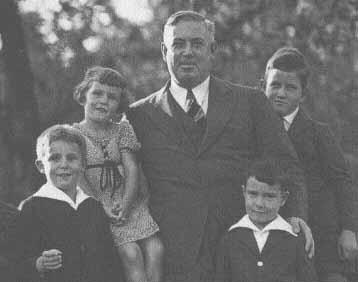 |
Marston’s forward thinking extended into his personal life as well, as he lived in a committed polygamous relationship with two women, one his wife Elizabeth Holloway and the other a former student: none other than the aforementioned Olive Richard, author of the FAMILY CIRCLE piece that first got M.C. Gaines’ attention. Marston had two children with each woman, and the four children and three parents lived together happily. It should be noted that Olive, by the way, reportedly was a slim, athletic woman with black hair and blue eyes, who wore large Indian metal bracelets on her wrists for many years. Sounds a bit familiar, does it?
Marston came back to Mayer with a synopsis for a character called “Suprema, the Wonder Woman.” Marston’s intentions for the character were plain – he planned to introduce a character who would be “tender, submissive, peaceloving as good women are,” combining “all the strength of a Superman plus all the allure of a good and beautiful woman.” Marston’s emphasis on submission, which appears again and again throughout his comics work, is at times contradictory, as he later wrote about WONDER WOMAN’s male readers, “ Give them an alluring woman stronger than themselves to submit to, and they’ll be proud to become her willing slaves!”
Mayer wisely cut the name “Suprema,” sticking with “Wonder Woman” as the name of the feature and title character. Over Mayer’s objections, Marston chose newspaper artist Harry Peter (credited in the comics as “H.G. Peter”) to illustrate the feature, claiming merely “he knew what life is all about.” As we’ll discuss later, Marston undoubtedly had other motives in mind.
Wonder Woman made her debut as a backup story appearing in ALL-STAR COMICS #8 (December 1941 – January 1942), in “Introducing Wonder Woman,” credited to Marston’s sobriquet, Charles Moulton, with art by H.G. Peter. The story opens with the crash of a U.S. Army plane on the mysterious Paradise Island, an uncharted isle populated by the Amazons, a tribe of beautiful and scantily clad women. The plane and its injured occupant, Captain Steve Trevor, are discovered by Diana, daughter of Hippolyte, Queen of the Amazons.
 |
As Trevor is nursed back to health by the Amazon doctors, the lovestruck Diana asks her mother why she can’t stay and attend the wounded airman. Hippolyte then tells Diana the story of the Amazons, how they were taken into slavery by Hercules, who defeated her in personal combat through trickery, and how the goddess Aphrodite helped Hippolyte and the Amazons escape and vanquish Hercules and his armies. In return for Aphrodite’s help, the Amazons agreed to leave the world of Man and establish a new world of their own on Paradise Island. As long as they remain on Paradise Island and do not permit themselves to again be deceived by men, they remain young, strong and immortal. Aphrodite also decreed that the Amazons must always wear the bracelets fashioned from their captors’ chains, “as a reminder that we must always keep aloof from men.”
Speaking of Aphrodite, she and her fellow goddess Athena manifest before Hippolyte, and tell her that one of the Amazons, the strongest and bravest, must take Steve Trevor back to America and then stay in Man’s World, to help defend America, “the last citadel of democracy, and of equal rights for women.” To determine the strongest and bravest, Hippolyte prepares a tournament, which she forbids her daughter Diana to enter, unable to bear the possibility of her daughter leaving Paradise Island. As the contest commences, the finalists are narrowed down to two, one of whom is wearing a mask. The final two engage in the contest of “Bullets and Bracelets” which is pretty much just what it sounds like, as the two take turns deflecting pistol shots with their wrist bracelets. The masked Amazon easily deflects the bullets fired at her, then wounds her opponent in the shoulder, winning the contest.
 |
Naturally, the masked Amazon is Diana, and Hippolyte has no choice but to name her the winner and award her the uniform and title of Wonder Woman.
Wonder Woman’s first adventure continued in the first issue of SENSATION COMICS (January 1942), which picked up the story with the Amazon princess returning the injured Steve Trevor to America in her trademark invisible plane (described here as merely “transparent”).
 |
After Wonder Woman drops off Trevor at Walter Reed hospital in Washington, she begins to explore Man’s World, and soon finds herself foiling a robbery. Her “bullets and bracelets” trick is noticed by a passing theatrical agent who puts her on the stage, allowing Diana to make some quick cash while Trevor recuperates. In one of those “only-in-comics” coincidences, Princess Diana runs into a despondent nurse at the steps of the hospital, who can’t join her fiancé in South America due to lack of funds. Since Diana needs a position as a nurse to be near Steve Trevor, and has a fistful of cash from her theatre gig, an arrangement is quickly made. Soon the nurse is off to join her fiancé, never to be seen again, while Princess Diana takes over the nurse’s identity. The nurse’s name? Diana Prince, of course.
 |
Soon Steve Trevor is up and around and back in harm’s way, going after a mystery bomber who plans on dropping poison gas on the local army camp. In what would become a series trademark, Wonder Woman again rescues Trevor, plucking him from the air after he crashes yet another plane.
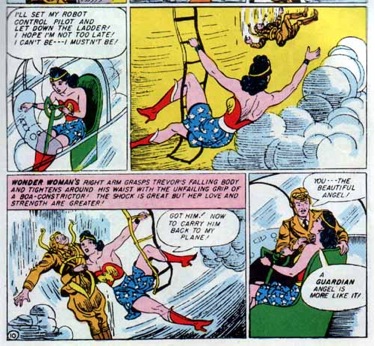 |
In succeeding issues would be introduced Wonder Woman’s golden lasso of truth, which is an interesting choice of weapon when one considers Marston’s pride in inventing the polygraph machine.
 |
It’s almost as if Marston was giving Wonder Woman the same power he felt he’d given the world: the ability to determine truth from lies. It’s also interesting in that the lasso is entirely a weapon of submission, of rendering your opponent helpless. This theme of submission is one that Marston would return to again and again, such as in the final piece of major business added to the Wonder Woman concept, the revelation that Wonder Woman becomes powerless when bound by a man.
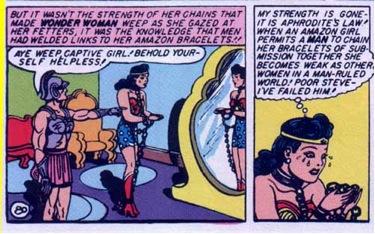 |
Not only does this detail further underline Marston’s feminist agenda in the series, by subtly reinforcing his premise that women in American society must free themselves from male domination if they’re ever to be truly strong and independent, but it also provided a convenient excuse for Wonder Woman to be tied up, chained, shackled, gagged and otherwise restrained literally hundreds of times over the course of the series, all lovingly illustrated in Peter’s pulpy, disturbingly adult style. This, I believe, was the real reason for Marston’s insistence on Harry Peter as the WONDER WOMAN artist: Marston’s intention was to subtly infuse the comic with highly suggestive imagery, so as to keep the attention of male readers, particularly young adolescent males, who might otherwise hesitate to buy what could be seen as a “girls’ comic book.” Once Marston had pulled in the readers with Peter’s lurid bondage art, he had a captive audience on whom to proselytize his feminist agenda. All things considered, it’s a pretty good idea: using men’s baser instincts to draw them in, so as to expose them to a more enlightened agenda.
Think I’m exaggerating? Well, then, let’s take a look at a few examples.
First off, here’s a moment from WONDER WOMAN #2, in which Mars, the God of War, makes an arrangement with Mussolini to capture Wonder Woman. No, really. Anyway, Musssolini’s stooges quickly deliver Wonder Woman and her lapdog – I mean boyfriend – Steve Trevor over to Mars’ lackey Lord Conquest, where special precautions are taken with their Amazon captive:
 |
Not convinced yet? Here’s another of Wonder Woman’s encounters with Mars. By the way, in case you weren’t getting the point that male domination is bad, check out this exchange between Mars and his “slave-secretary:”
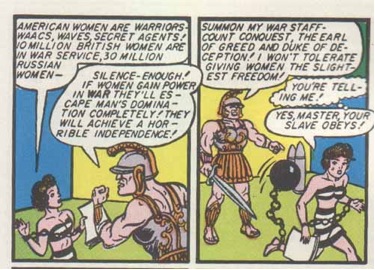 |
So Mars’s agent on Earth this time is the fiendish Doctor Psycho, a deformed physician framed for theft by his fiancée Marva and her boyfriend. Once out of jail, he forces her to marry him, then continues to use her in “occult experiments,” eventually becoming able to manipulate ectoplasm, using the bound and blindfolded Marva as his medium.
 |
The anti-woman séances attract the attention of Wonder Woman. After Psycho disguises himself as the spirit of George Washington (it just gets weirder and weirder, doesn’t it?), he declares that top-secret papers will be stolen by office girls, which naturally necessitates that the girls be strip-searched.
 |
Eventually, even Wonder Woman’s spirit is chained up, thanks to Dr. Psycho’s bizarre occult science.
 |
With a little help from Wonder Woman’s friends Etta Candy and the Holliday girls, a group of sorority girls from nearby Holliday College, Diana is saved and Psycho is foiled, and Marva is given a sisterly pep talk from Wonder Woman, again focusing on submission and domination.
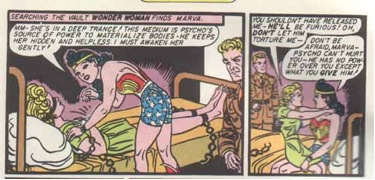 |
(Curiously, no mention is made of the fact that none of this would have happened if Marva hadn’t framed Psycho to begin with. Ah, well – guess it didn’t fit the agenda…)
Here’s another example, as Diana returns to Paradise Island to help initiate and encourage the young Amazons who are taking their test to earn their bracelets. Where exactly these young Amazons are coming from, since there are no men allowed on the island, is unclear. Anyway, to inspire the girls, Wonder Woman instructs them to tie her up, and swiftly breaks free, saying “it’s easy to break bonds if you know you can!”
 |
Before long, Wonder Woman is summoned to the South Pole, where the sunken Garden of Eden still thrives, to rescue the daughter of Eden’s Queen from the Seal Men. It’s like a fever dream. So Wonder Woman inspires the women of Eden just as she did the young Amazons, and the women attack the Seal Men’s icy realm, but are swiftly captured.
 |
Of course, Wonder Woman is quickly tied up, but apparently Aphrodite’s rule about men tying her up doesn’t apply to Seal Men, because she easily breaks her bonds and frees the rest of the captives, some of whom are about to be frozen for later use as slaves.
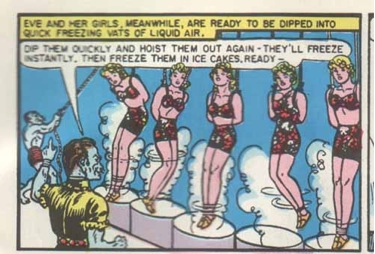 |
Once more, Diana inspires the women to free themselves from male domination, even if it is Seal-man domination…
 |
Another example can be found in “When Treachery Wore a Green Shirt!”, a tolerance tale which pits Wonder Woman against Dr. Frenzi and his Greenshirt Gang, who travel from town to town stirring up hatred against foreigners and immigrants. After breaking up a lynching, Wonder Woman is surprised by Frenzi’s goons and once again bound into submission by men.
 |
For once, Steve Trevor makes himself useful and actually comes to the rescue, breaking Wonder Woman’s chains with a well-placed bullet. The hatemonger in custody, Wonder Woman is hoisted into the air for some stirring closing thoughts. (And by the way, Steve better watch those hands…)
 |
For a final look at the dominance dynamic between Wonder Woman and Steve Trevor, take a look at “The Lawbreaker’s League,” in which criminals plot to eliminate Wonder Woman by marrying her off to Trevor, which could naturally only happen if Trevor was stronger than the Amazon. Sure. So they expose Steve to an electronic globe that releases brain energy to his muscles at will, and sure enough, soon Steve is manhandling Diana, promising to make her listen.
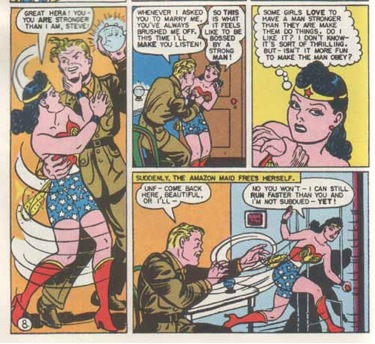 |
Charming. After the usual nonsense involving Etta Candy and the Holliday girls being kidnapped, and the standard scene of Wonder Woman being tied up head to toe …
 |
… the Lawbreaker’s League is captured, after which Diana tells Steve that she could never love a dominant man. Trevor immediately smashes the globe, happily returning to his weaker role in his relationship with Diana, who, it should be noted, still can’t commit:
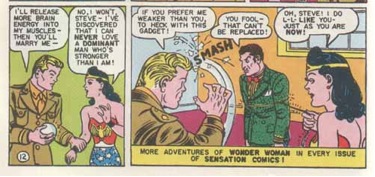 |
In 1947, William Moulton Marston died, and artist Harry Peter left the strip not long after. What would become of Wonder Woman without the dedicated if single-minded talents of her creators? Come back next week to find out.

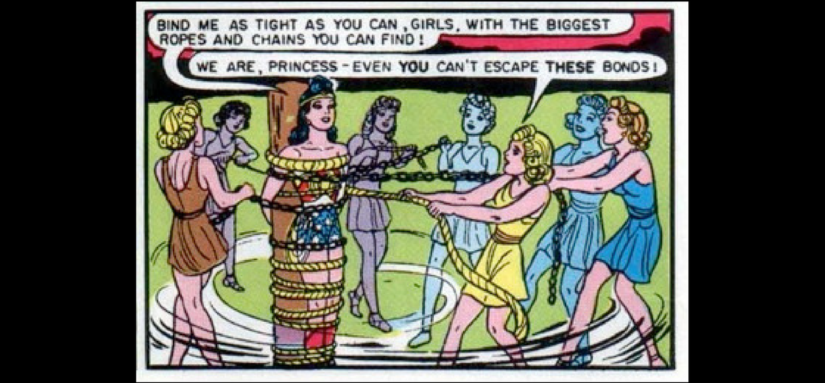
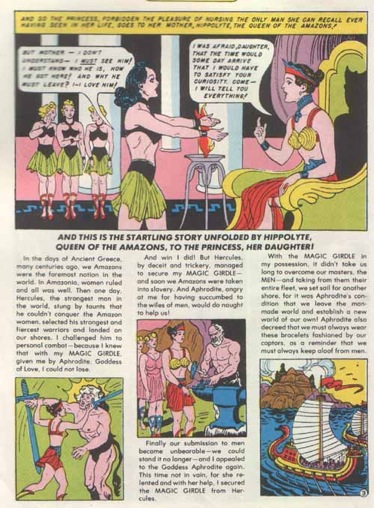
Comments are closed.